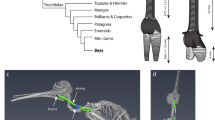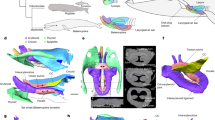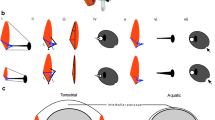Abstract
MOST echolocating porpoises and small whales (odontocete) possess a fatty protrusion on the forehead and a peculiarly formed lower jaw which flares into a posterior flange. Overlying this flange is a region of highly fatty tissue referred to by Norris1 as an acoustic window. The fatty tissues (>80% lipid) of the mandible and the melon are believed to be associated with sound transmission1–3. It is proposed4,5 that the melon functions as a sound lens, a concept consistent with the view that it is heterogeneous in terms of sound velocity and refraction6. Recent studies7–13 revealed that the lipids of acoustic tissues are different from those of the surrounding tissues. For example, the acoustic tissues contain triacylglycerols and wax esters rich in short and medium chain (C5–C12) acids, whereas blubber tissues are composed primarily of triacylglycerols containing long chain (C14–C22) acids. In the families Delphinidae7–9 and Monodontidae12, isovaleric acid (3-methyl butyric acid) and longer iso (gem-dimethyl) acids are present in large amounts in acoustic tissues. Furthermore, certain areas, such as the acoustic window and the inner melon, contain almost exclusively l,3-diisovaleroyl-2-acylglycerols and isovaleroyl wax esters (Fig. 1). These compounds are replaced by medium and long chain triacylglycerols in adjacent areas. Thus, specific lipid compositions with various proportions of branched structures are found in the putative areas of sound transmission14,15. The intriguing association between proposed acoustic pathways and unique lipid composition led us to study the acoustic properties of these lipids.
This is a preview of subscription content, access via your institution
Access options
Subscribe to this journal
Receive 51 print issues and online access
$199.00 per year
only $3.90 per issue
Buy this article
- Purchase on Springer Link
- Instant access to full article PDF
Prices may be subject to local taxes which are calculated during checkout
Similar content being viewed by others
References
Norris, K. S., in Evolution and Environment: a symposium on 100th anniversary Peabody Museum Natural History (edit, by Drake, E. T.), 297–324 (Yale University Press, New Haven, 1968).
Norris, K. S., in Biochemical and Biophysical Perspectives in Marine Biology, 2 (edit, by Malins, D. C., and Sargent, J. R.), 215–236 (Academic, London, 1975).
Bullock, T. H. et al., Z. vergl. Physiol., 59, 117–120 (1968).
Norris, K. S., in Marine Bio-acoustics (edit, by lavolga, W. N.), 317–336 (Pergamon, New York, 1964).
Schevill, W. E., in Marine Bio-acoustics (edit, by Tavolga, W, N.), 309 (Pergamon, New York, 1964).
Bel Kovich, V. M., and Nestorenko, J. I. Naturwissenshaftliche Rundschau, Stuttgart, 25, 143–145 (1972).
Varanasi, U., and Malins, D. C., Biochemistry, 9, 3629–3631 (1970).
Varanasi, U., and Malins, D. C., Biochemistry, 9, 4576–4579 (1970).
Varanasi, U., and Malins, D. C., Biochim. biophys. Acta, 231, 415–418 (1971).
Varanasi, U., and Malins, D. C., Science, 176, 926–928 (1972).
Litchfield, C., Ackman, R. G., Sipos, J. C., and Eaton, C. A., Lipids, 6, 674–681 (1971).
Robisch, P. A., Malins, D. C., Best, R., and Varanasi, U., Biochem. J., 130, 33–34P (1972).
Varanasi, U., and Malins, D. C., Biochim. biophys. Acta, 348, 55–62 (1974).
Varanasi, U., Everitt, M., and Malins, D. C., Int. J. Biochem., 4, 373–378 (1973).
Varanasi, U., and Malins, D. C., Biochem. Soc. Trans., 2, 1277–1279 (1974).
Norris, K. S., and Harvey, G. W., J. acoust. Soc. Am., 56, 659–664 (1974).
Malins, D. C., Robisch, P. A., and Varanasi, U., Biochem. biophys. Res. Commun. 48, 314–319 (1972).
Christophe, J., in Biochemical Problems of Lipids (edit, by Frazer, A. C.), 373–384 (Elsevier, New York, 1963).
Malins, D. C., and Varanasi, U., in Biochemical and Biophysical Perspectives in Marine Biology, 2 (edit, by Malins, D. C., and Sargent, J. R.), 237–289 (Academic, London, 1975).
Morris, R. J., Deep Sea Res., 20, 911–916 (1973).
Achman, R. G., Eaton, C. A., and Litchfield, C., Lipids, 6, 69–77 (1971).
Schaaffs, W., Ergeb. exakt. Naturwiss, 24, 109–192 (1951).
Author information
Authors and Affiliations
Rights and permissions
About this article
Cite this article
VARANASI, U., FELDMAN, H. & MALINS, D. Molecular basis for formation of lipid sound lens in echolocating cetaceans. Nature 255, 340–343 (1975). https://doi.org/10.1038/255340a0
Received:
Accepted:
Issue Date:
DOI: https://doi.org/10.1038/255340a0
This article is cited by
-
Mechanics to pre-process information for the fine tuning of mechanoreceptors
Journal of Comparative Physiology A (2019)
-
Distribution and development of the highly specialized lipids in the sound reception systems of dolphins
Journal of Comparative Physiology B (2009)
-
1H and 13C NMR studies of melon and head blubber of the striped dolphin (Stenella coeruleoalba)
Lipids (2006)
-
High concentrations of isovaleric acid in the fats of odontocetes: variation and patterns of accumulation in blubber vs. stability in the melon
Journal of Comparative Physiology B (2003)
Comments
By submitting a comment you agree to abide by our Terms and Community Guidelines. If you find something abusive or that does not comply with our terms or guidelines please flag it as inappropriate.



